卢森堡的秋天
Luxemburg is a small country in the north of France. I took one day to visit it during my trip of Alsace and Lorraine in the autumn of 2020. I took the TER train from Metz and it only took one and half hours to arrive in the capital of this country, Luxemburg city. Luxembourg is one of the smallest sovereign states in Europe but it has amazingly one of the the highest GDP per capita in the world.
卢森堡是法国北部的一个小国。 我在2020年秋天阿尔萨斯和洛林的旅行中特意花了一天时间参观了它。我从梅斯乘坐TER火车,只用了一个半小时就到达了这个国家的首都卢森堡市。 卢森堡是欧洲最小的主权国家之一,但令人惊讶的是,它是世界上人均 GDP 最高的国家。

Although this country is extremely small, it has its own railways systems connecting many villages in the country. This train station has a typical German façade in the traditional Moselle Baroque Revival style. It was built at the beginning of 20th century. At that period, German architects preferred to build train stations with a clock tower and a triangle roof-top main building.
虽然这个国家非常小,但它有自己的铁路系统连接该国的众多村庄。这个火车站有典型的德国外观,采用传统的摩泽尔巴洛克复兴风格。它建于20世纪初。在那个时代,德国建筑师更喜欢建造带有钟楼和三角形屋顶主楼的火车站。

I visited the city in late autumn on foot and it was a gloomy and cold morning accompanied by gusts of bleak wind which blew off the frosty dews from twigs. The first view of the city was the tortuous Petrusse valley. I walked from the train station in the south towards the city area and must cross this valley. The leaves of trees in autumn had turned to mixed red and yellow. From faraway, the colorful forest in the valley looked like a polychrome decorating the skyline of the city. At the bottom of the valley, I could see the Skatepark clearly. The visitors could go to the bottom and have a hiking along the valley.
我在两年前的深秋步行游览了这座城市,那是一个阴寒的早晨,秋风萧瑟天气凉,草木摇落露为霜。来到这座城市的第一印象就是眼前蜿蜒曲折的佩特鲁斯山谷。我从南边的火车站向市区进发,必须穿过这个山谷。深秋包含风霜的树叶此刻已经变成了斑驳的红色和黄色。远远望去,山谷中五彩斑斓的森林就像一片点缀城市天际线的彩玉。在山谷的底部,我还可以清楚地看到一个滑板公园。游客亦可以下到谷底,沿着山谷徒步旅行。

There are two bridges connecting to the center of the city. I was standing on one of the bridge and staring at the another bridge called Adolphe Bridge which was the city landmark. This bridge was inaugurated in 1903 and named after Grand Duke Adolphe, who reigned over Luxembourg from 1890 until 1905. Under the bridge, the wild profusion of vegetation is shrouded by the autumn mists.
共有两座桥连接到市中心。我站在其中一座桥上凝视着另一座名为阿道夫桥的桥,它也是这座城市的地标。这座桥于 1903 年落成,以 1890 年到 1905 年期间在卢森堡统治的阿道夫大公命名。桥下茂密的植被被秋天的薄雾笼罩。

Across the bridge Passerelle, I walked along the main avenue towards the historic center Haute Ville which means high city. This area is located at the top of a rock called ‘Bock’. In 963, Count Siegfried named the rocky promontory as the Bock, and established his residence there. Later, a small fort called Lucilinburhuc stood on this spot, and the word “Luxembourg” evolved from this name. Travelers will see this high rising gothic building with a tower first when they cross the bridge Passerelle. The Notre-Dame Cathedral was built in 1613 and the only cathedral in Luxembourg.
穿过 Passerelle 桥,我沿着主干道走向老城区 Haute Ville,它的意思是高城。这片区域位于名为“博克”的岩石顶部。963 年,齐格弗里德伯爵将这片突出的岩石角命名为博克,并在那里建立了他的住所。后来一个名叫Lucilinburhuc的小堡垒矗立在这片土地上,“卢森堡”一词就是从这个名字演变而来的。 穿过Passerelle 桥游客将首先看到这座高耸的哥特式建筑。这座卢森堡圣母院建于 1613 年,是这里唯一的天主教大教堂。

Opposite to the cathedral, it’s the famous square of constitution where all the visitors will come and take a photo. It has the beautiful monument “Gëlle Fra”, which includes a golden statue at the top and two bronze statues in below. It was built in 1923 to honor the Luxembourgish volunteer soldiers who fought alongside the French army during the war. Here we could find the Luxemburg national flag waving in the cold wind.
大教堂对面是著名的宪法广场,所有来卢森堡的游客都会来这里拍照留念。它有一座美丽的纪念碑“Gëlle Fra”,顶部是一座金色雕像,下方有两座青铜雕像。它建于 1923 年,纪念在一战期间与法国军队并肩作战的卢森堡志愿兵。这里卢森堡的三色国旗在寒风中飘扬。

I was standing at the edge of the square and enjoyed one of the most imposing views of the city. At the background, the bronze top tower building was the The State Bank and Savings Fund of Luxemburg. Also we could see the familiar Adolphe bridge together with the deep Pétrusse River Valley covered by the giant trees. This is the symbolic scene that always appears at the postcard of Luxemburg.
我站在广场的栏杆边欣赏着这座城市最壮丽的景色。照片背景中的青铜顶塔楼是卢森堡的国家储蓄基金银行,这里还可以看到熟悉的阿道夫桥以及被参天大树覆盖的深邃的佩特鲁斯河谷。这也是卢森堡明信片上经常出现的标志性场景。

In the quarter of High city, there are many historical administrative buildings. Place Guillaume II is the major city square where the town hall of Luxemburg is located at. This neoclassical style building flanked by two leonine sculptures is the city hall. Lion represents the city of Luxembourg, which is reflected on its coat of arms. The history of this square could be traced back to the French Revolutionary Wars in 1797. At that time the original monastery at this place is changed to this square after the visit of Napoleon. Luxemburg’s major language is French and German. Most of its place is named in French.
在高城区,有许多历史悠久的行政建筑。纪尧姆二世广场是卢森堡市政厅所在的最重要的城市广场。这座新古典主义风格的建筑两侧装饰着两座狮子雕塑,它就是卢森堡市政厅。狮子代表卢森堡市,在卢森堡的国徽上也有体现。这个广场的历史可以追溯到1797年的法国大革命战争时期。拿破仑到访后这里原来的修道院被改为这个广场。卢森堡的主要语言是法语和德语,它的大部分地方都是用法语命名的。

In the center of the square, it is the equestrian statue of Grand Duke William II who was the King of the Netherlands and the Grand Duke of Luxembourg from 1840 to 1849. The pedestal of the monument shows the coat of arms of the House of Orange-Nassau and of Luxembourg and the ones of the 12 cantons of Luxembourg.
广场中央是 1840 年至 1849 年期间荷兰国王和卢森堡大公威廉二世的骑马雕像。纪念碑的基座上展示着拿骚-奥兰治家族的家徽以及卢森堡12 个州的纹章。
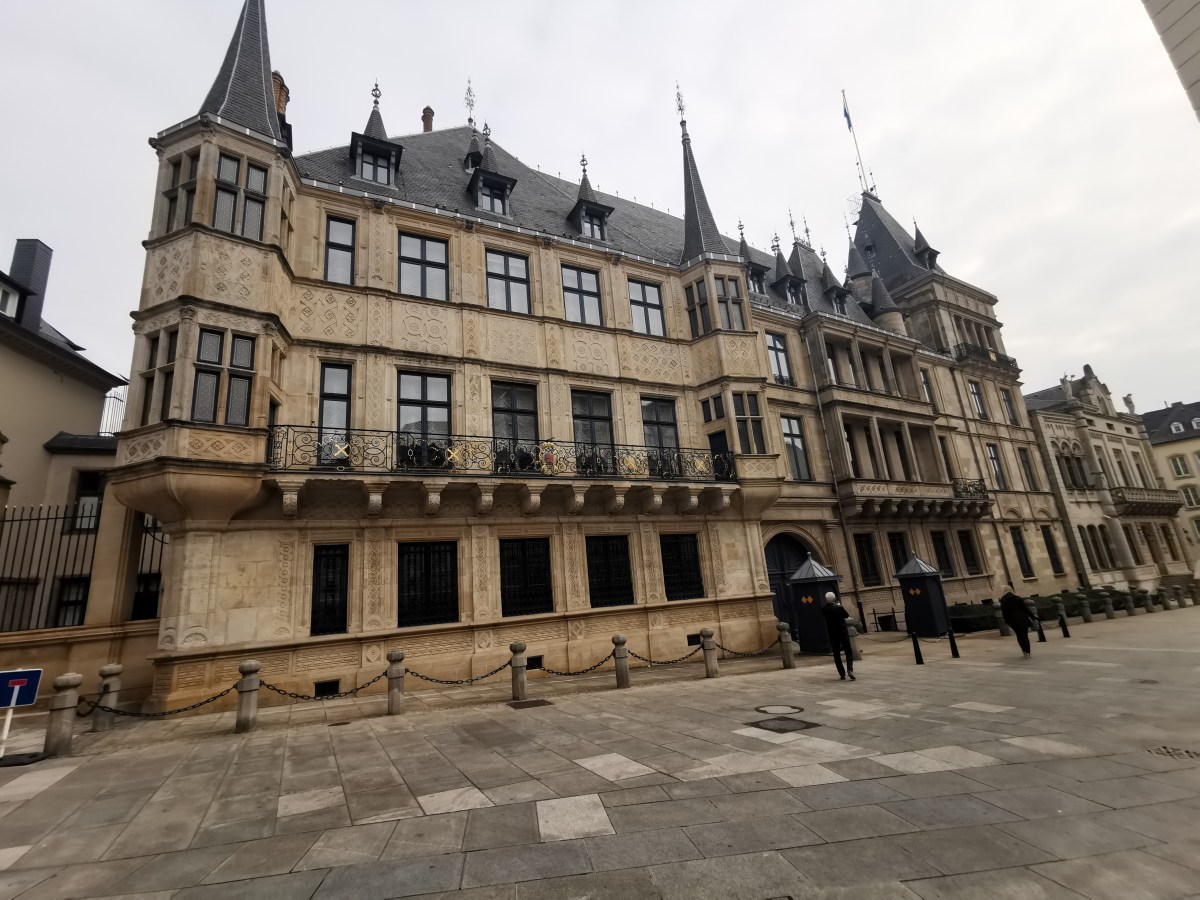
In medieval time, Luxembourg was part of the medieval Kingdom of Germany, and later the Holy Roman Empire. It became a grand duchy in 1815 and half-independent state under the Netherlands. It gained full independence in 1867. The constitution of 1841 created the Assembly of Estates which formed the parliament of Luxemburg nowadays. Most of the administrative and legislative buildings of Luxemburg are located in this area not far from the Place Guillaume II. This building is the official residence of the Grand Duke of Luxembourg where he performs most of his duties as head of state of the Grand Duchy. It was first the city hall of Luxembourg from 1572 to 1795. After Luxemburg gained independence, it became the Grand Ducal palace. Now it is used to accommodate the foreign heads of state. There are two guards at the entrance.
在中世纪,卢森堡是德意志王国的一部分,后来就成为神圣罗马帝国的一部分。1815年它成为大公国,在荷兰统治下成为半独立国家。卢森堡最终在 1867 年获得完全独立。1841 年的宪法创建了现在组成卢森堡议会的三级会议。卢森堡的大部分行政立法大楼都位于这里,距纪尧姆二世广场不远。这座建筑是卢森堡大公的官邸,卢森堡大公作为大公国的国家元首在这里办公。1572年至1795年期间,它最初是卢森堡的市政厅,卢森堡获得独立后成为大公宫殿。它现在用来接待外国元首。门口有两个守卫把守。

In 19th century, the Chamber of Deputies of Luxemburg had no regular meeting place, so such a building was built in 1860 next to the Grand Ducal palace for the parliament meeting. The angels at the façade symbolize the legislative power, that is administrated by the Grand Duke in conjunction with the Chamber. The Chamber of Deputies is unicameral and contains 60 seats. Deputies are elected to serve five-year terms.
19世纪,卢森堡众议院没有固定的会议场所,所以1860年在大公宫旁边建造了图中这个建筑,以供议会会议使用。建筑立面的天使象征着由大公与议事厅共同管理的立法权。卢森堡众议院是一院制的,有60个席位。代表任期五年。
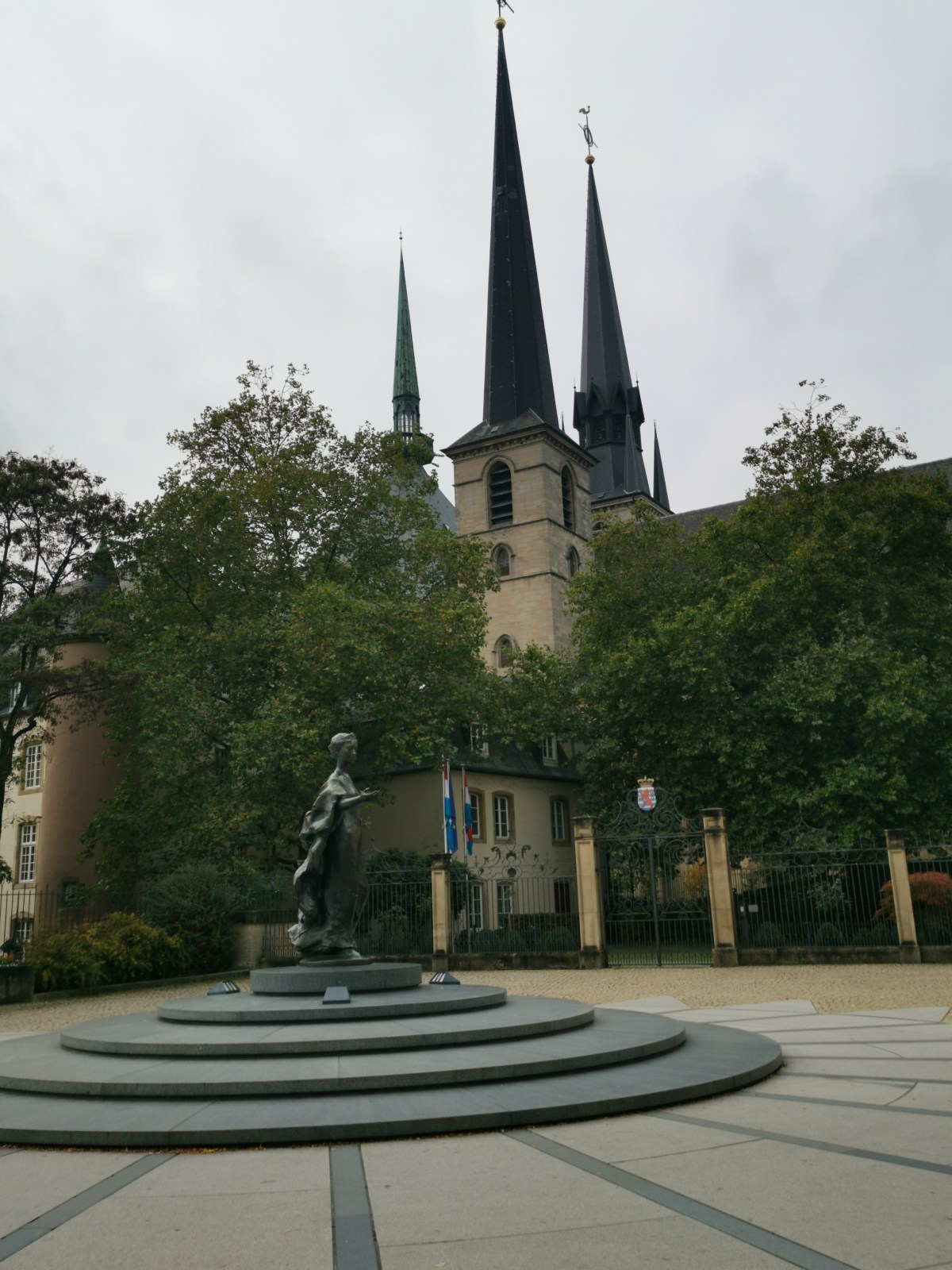
At the back of the Square Guillaume II, I could see the statue of Grand Duchess Charlotte which was designed by the French sculptor Jean Cardot. On 29th April 1990, the 2.75-metre high bronze statue was officially inaugurated in the presence of the Grand Ducal family to honor Grand Duchess Charlotte who ruled Luxemburg from 1919 to 1964 and was very popular with the Luxembourgers. She was from the House of Nassau-Weilburg which still ruled Luxembourg today which is a branch of the Nassau family from Netherlands.
在纪尧姆二世广场的后面,我可以看到由法国雕塑家让·卡多设计的夏洛特大公雕像。1990 年 4 月 29 日,这座 2.75 米高的铜像在大公家族的见证下正式落成,以纪念从 1919 年到 1964 年期间统治卢森堡并深受卢森堡人欢迎的夏洛特大公。她来自于今天仍然统治着卢森堡的拿骚-威尔堡家族,这个家族是荷兰的拿骚家族的分支。
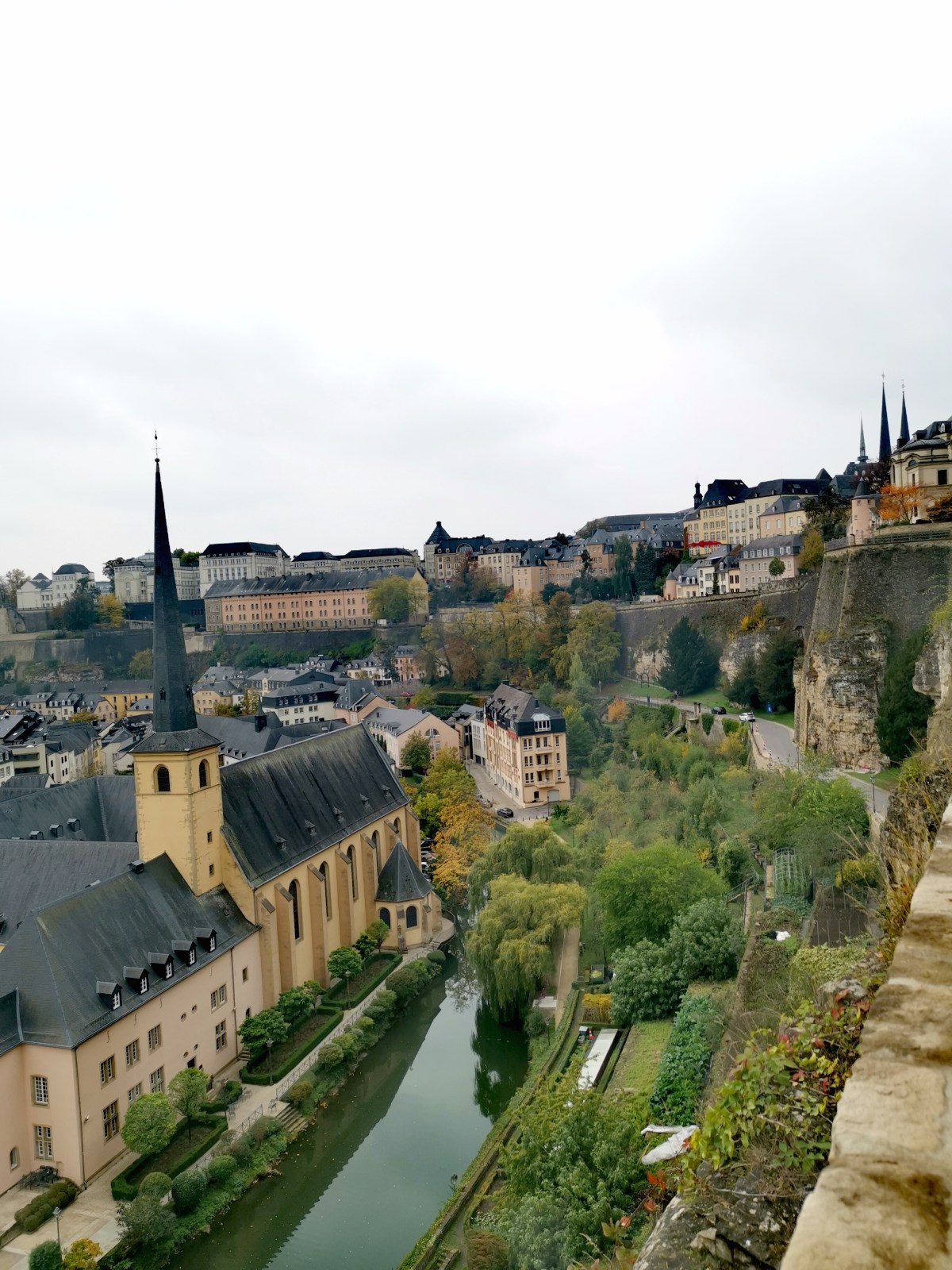
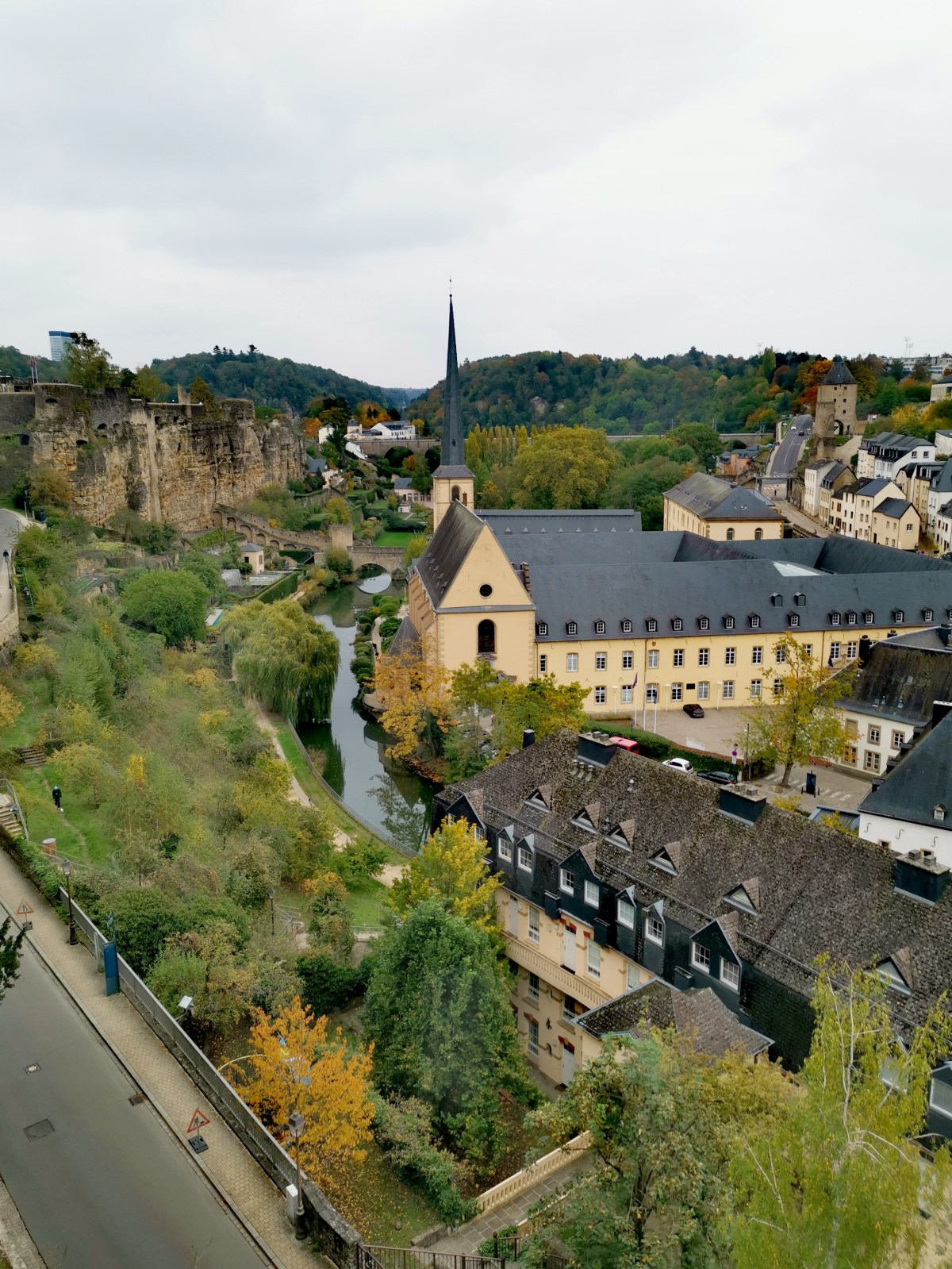
The most beautiful part of this city must be this road called the scenic road which connects to the Grund quarter under the ‘Bock promontory’. It is praised as the most beautiful balcony of Europe by the Luxembourg writer Batty Weber. It runs along the Alzette valley on the ramparts built by the Spaniards and the French in the 17th century. The visitors could lean over the remnants of the historical walls to have a superb panoramic view of the valley of the Alzette and the houses of city district of Grund.
这座城市最美丽的地方一定是这条连接“博克角”下的格伦德区的风景走廊。它被卢森堡作家巴蒂·韦伯誉为欧洲最美的阳台。它位于 17 世纪西班牙人和法国人建造的城墙上沿着阿尔泽特山谷延伸。游客可以俯身在当年的残垣断壁上,欣赏阿尔泽特山谷和格伦德区的壮丽全景。

The Casemates Bock is a network of underground fortifications, built in the 18th century. The fortifications are recognized as a UNESCO World Heritage Site in 1994. The Bock itself is the rock on which the first castle stood, founded in 963. Luxemburg used to a military fortification which is important for both French and German. The fortress was of great strategic importance for the control of the left bank of the Rhine and the border area between France and Germany. The fortification is later expanded by Vauban, the famous French military engineer. The subterranean defensive passages were placed on different levels and reached down as far as 40 meters. These impressive defensive works conferred Luxembourg the name of “Gibraltar of the North”.
博客要塞(Casemates Bock) 是一个地下防御工事网络,建于 18 世纪。 这些防御工事于 1994 年被联合国教科文组织列为世界遗产。博克本身就是第一座始建于 963 年城堡所在的岩石。卢森堡历史上是一座对法国和德国都很重要的军事要塞。它对于控制莱茵河左岸和法德边境地区具有重要的战略意义。这里的防御工事后来由著名的法国军事工程师沃邦扩建。地下防御通道分布在不同的层次,最深可达40米。这些令人望而生畏的防御工程令卢森堡获得“北方直布罗陀”的称号。
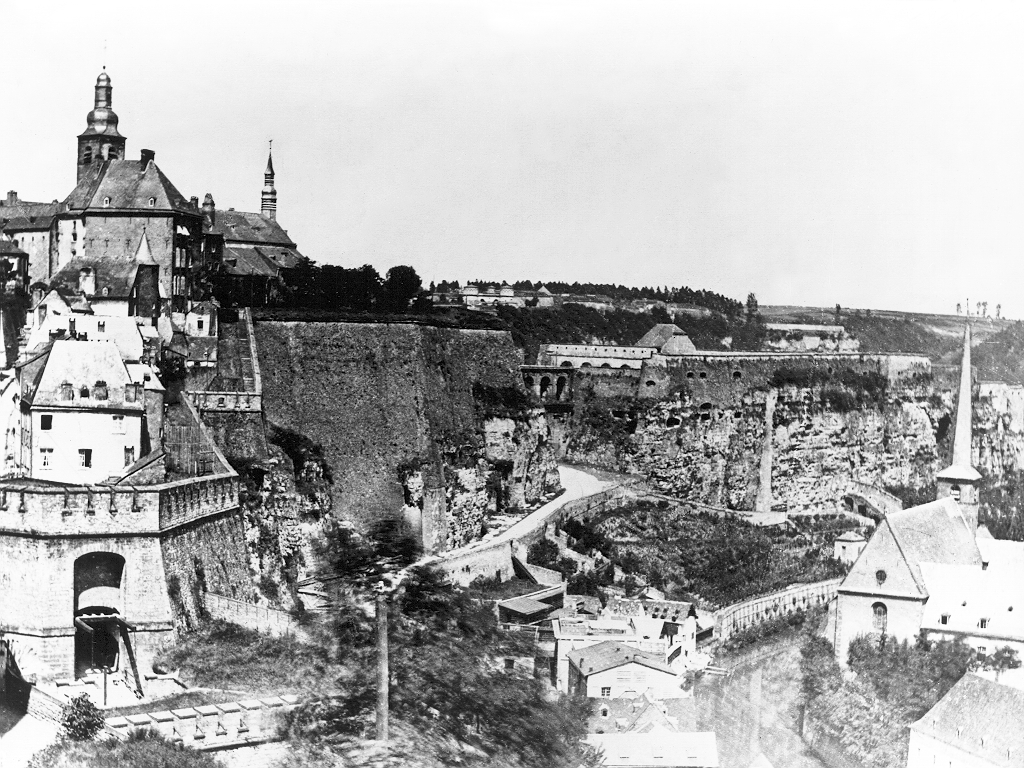
This is the black-and-white photo taken in 1867. The Fortress of Luxembourg at that time looks exactly the same with what I have seen now. It’s a miracle that it could be kept well for so long time.
这是1867年拍摄的黑白照片。当时的卢森堡要塞和我现在看到的一模一样。 昔日的山河还能完整保存这么久,真是个奇迹。

After the dismantling of the fortress in 1867, 17 kilometers of the casemates were spared, left in good condition. The Bock casemates have been open to the public for visit from 1933. When I walked around the Grund, I always stopped a while and looked at these remnants above me closely. The embrasures (shooting holes) of canons are still kept on the walls. They represented the long history of this city as a strong fortification.
1867年后这些堡垒均被拆除,不过有17公里的炮台完好无损保留至今。博克要塞从1933 年开始向公众开放参观。当我在格伦德区周围散步时,我总是会停下来仔细观察我上方的这些遗迹。一些大炮的射击孔仍然保留在墙上。它们代表着这座城市曾经作为坚固的防御工事的悠久历史。

The Grund is one of Luxembourg City’s oldest neighborhoods. As far back as the 14th century, there is a hospice located in the building that now houses the National Museum of Natural History. All the houses in this area have rooftops made of caesious brick and tiles. They will bring our memories back to the medieval times.
格伦德区(The Grund) 是卢森堡市最古老的街区。早在 14 世纪,这里就有一家福利院,如今这座建筑是国家自然历史博物馆的所在地。这个地区的所有房屋都是青砖黛瓦制成的屋顶。它们瞬间将我的记忆带回到中世纪。

The Grund is a lower part of the city and there are many small routes that connect the Haute Ville with the Grund. The Alzette is a small river winding through the Grund. It is a pleasure to walk along the river and deplore the historical buildings in the quarter. The long bridge at the back ground is a two-track railway viaduct towards France.
格伦德区是卢森堡市的低地区,有许多小路连接它和高城区。 阿尔泽特(Alzette)是一条蜿蜒穿过格伦德区的小河。沿着河边走走欣赏区内的历史建筑十分开心。背后的长桥是通向法国的两轨铁路高架桥。

Everyone will notice this building firstly when they glimpse through the Grund from faraway. After the original Benedictine abbey was destroyed in 1543, the Neumünster Abbey was built in the Grund. For centuries, its buildings were used as a prison, but today they are the site of the Neumünster cultural and community center.
每个人从远处扫视格伦德区时都会首先注意到这座建筑。这里曾经的原本笃会修道院于 1543 年被摧毁后,这座新明斯特修道院就此建立。几个世纪以来它被用作监狱,但如今它们变为文化和社区中心。

The Grund district is known for its quietness and its atmosphere of a small preserved village. It has a population of less than one thousand. It is quite suitable for travel. I preferred the old brick bridges over the river and some cobbled streets dated back to the 10th century. A gust of light wind whiffled through the trees and blew the yellow leaves into the babbling river. The houses perched at the highland were mirrored in the stillness of water. All the things are so silent except the whispers of winds. Here I could escape the hustle and bustle of the city center totally.
格伦德区以其宁静和保存完好的小村庄而闻名。它的人口不到一千。非常适合旅行。河上的旧砖桥和一些追溯到10 世纪的鹅卵石街道令人感到倾心。阵阵微风拂过,片片黄叶落入潺潺的河水。 高地的房屋倒映在寂静的水面上。这里的一切都是那么的寂静,唯有耳畔边风的细语,完全远离城市的喧嚣是多么的美好。

I was standing on one bridge and glanced at the surroundings. Their houses have the irregular shapes rooftops and equipped with chimneys but I am not sure whether these chimneys could be used or not today. The whole town was tranquil and there were only a few pedestrians passing by. Some Luxemburg local people were spending a leisure afternoon in the outdoors cafés at the riverside despite of the coolness of deep autumn.
我站在一座小桥上,环顾四周。 他们的房屋有不规则形状的屋顶,并配有烟囱,不过不确定这些烟囱如今还是否使用。整个小镇如此安静,路过的行人寥寥无几。 唯有若干当地人不顾深秋的凉意,在河边的露天咖啡馆度过了一个休闲的下午。

The buildings along the river were similar to the houses of German style. For me I liked this kind of old town with small rivers. It was nice to see some ducks frolicking in the stream. I preferred to spend more time in the Grund than the Haut ville. It is more like a scene in a bucolic poetry.
沿河的建筑类似于德国风格的小屋。对我而言我就特别中意这种在水一方的老城,同时也很开心看到一些鸭子在溪流中戏水。旅行途中我自然愿花更多的时间在格伦德区徜徉。这里更像是田园诗中赞颂的场景。

In the old town, I could always find many remnants of the Luxembourg fortress. This is the second gate of Trier constructed in 1590 in order to defend the fortress. It was equipped with a moat and a drawbridge that connected with the upper city. Today the drawbridge no longer exists and in its place it is just a footbridge over the Rue de Treves.
在老城区,我总能发现零零总总的卢森堡堡垒的遗迹。这是特里尔的第二座城门,建于 1590 年能够更好地保卫堡垒。它设有护城河和吊桥与高城区相连。如今吊桥已不复存在,取而代之的是特里尔街上的一座人行天桥。

The Three Towers are the remains of the old fortress of Luxembourg City as well. The square central tower dates from probably around 1200 while two circular flanking towers were added in the 14th century. They are one of the entrances to the old Town. From here I was leaving the old town and on my way back to the train station.
这个三塔建筑也是卢森堡城旧堡垒的遗迹。中间的方形中央塔的历史可能大约在1200 年左右,而在 14 世纪又增加了两座圆形侧塔。它们是老城区的入口之一。从这里我离开老城,踏上了回火车站的路上。

Before I left this city, I passed by this building accidently. Due to its historical façade, I thought it might be a museum or a school. However, it is actually a retirement sanatorium built in 1892. In 1853, Jean-Pierre Pescatore donated half a million francs to Luxembourg City to build it so this building was named by this philanthropist. It was really a great achievement, even today many old people still benefited from it.
在离开这座城市之前,我偶然路过这座建筑。 由于它的古老外观,我一度认为它可能是一座博物馆或学校。然而它实际上是一座建于1892 年的退休疗养院。1853 年,让-皮埃尔·佩斯卡托雷向卢森堡市捐赠了 50 万法郎来建造它,因此这座建筑也被这位慈善家命名。这真是一项壮举,直到今天仍有许多老人从中受益。
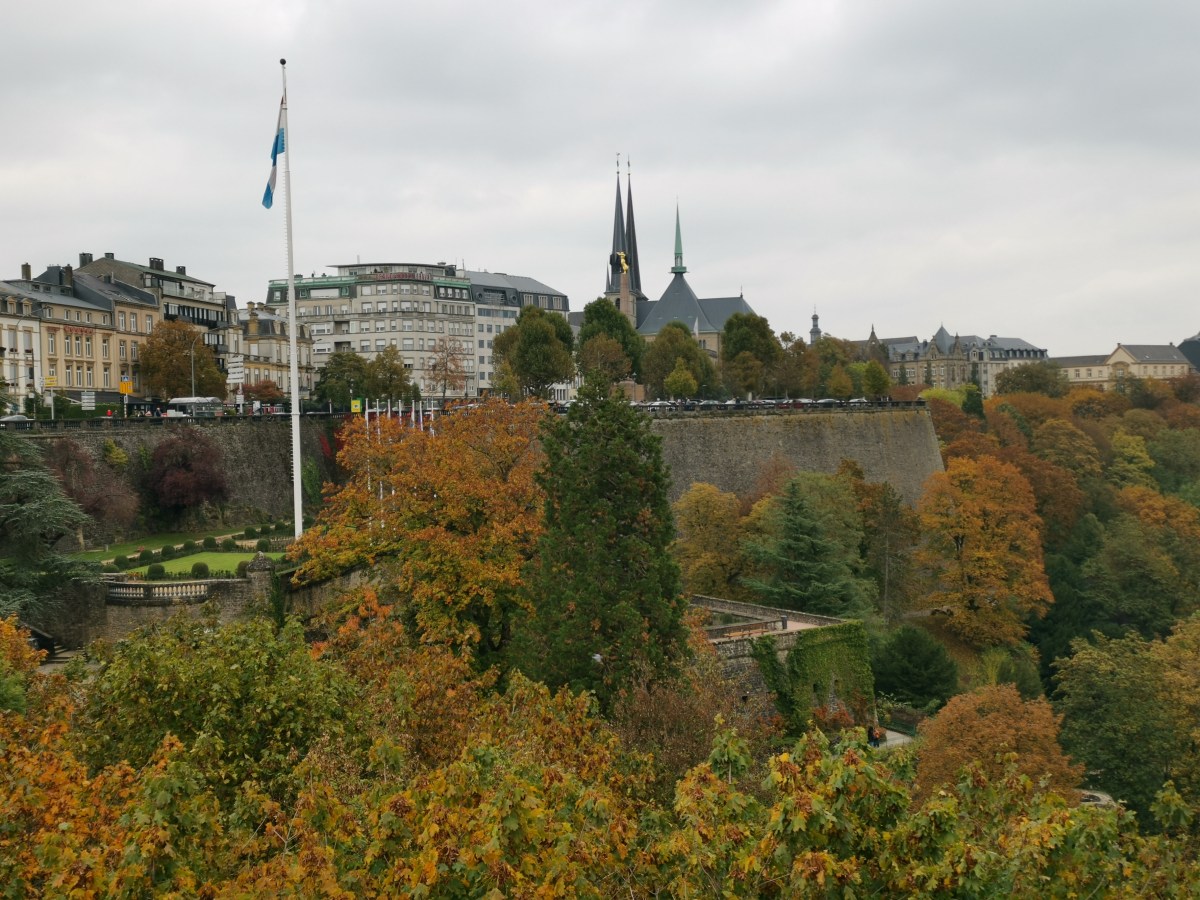
It has been two years since I visited this city. I still conserved some memories of it, the colorful autumn leaves in the long valley, the undulations of ridges and hills, and the waving flags in the Constitution square. Luxemburg is indeed a small country but it still has many things to be explored as long as you have interests of old buildings and history. It’s a bit cold, cloudy, and misty in the autumn but the beautiful florid colors of fall foliage will bring unique charm to this city.
我游历卢森堡市已经过去两年了,至今还保留着一些残存的记忆比如幽长峡谷的红叶,起伏的山峦,宪法广场飘扬的旗帜。。。 卢森堡确实是一个小国,但只要你对老建筑和历史感兴趣,它仍然有很多值得探索的地方。它的秋天冷冷清清,并且云雾缭绕,不过秋叶的绚丽色彩也为这座城市带来了独特的魅力。
